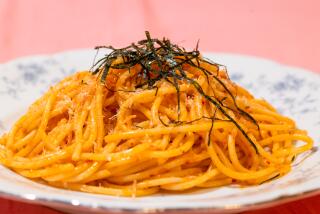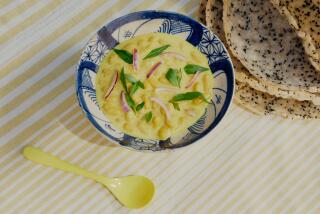IN THE KITCHEN : Inconvenience Food: Shrimp ‘n’ Beans
Everyone’s always going on and on about convenience foods. What about inconvenience foods? Surely, two of the most inconvenient foods you’ll ever run across are fava beans and shrimp. But combine them in a stew-y kind of shrimp broth and boy, is it ever worth the effort.
Actually, effort is the wrong word here. Nothing about this dish is very difficult. It’s just time-consuming . . . but what do you expect from fava beans and shrimp?
Besides, most of that time is in advance preparation. There are two kinds of difficult dishes: front-loaded and back-loaded. The front-loaded are the ones that drive me nuts--you’ve got a dozen things to do at the last minute and you need a support staff of 12 just to get the dish on the table.
This one is definitely back-loaded. You may spend an hour getting everything ready to cook, but when it comes time to serve, you basically just have to heat everything through. Think of all that prep work as something to do on a Saturday morning while you’re watching the ball game or the cooking shows on KCET.
*
I’ve talked about my problems with fava beans before, yet it seems that every spring, I have to fix them three or four times--the first because I’ve temporarily forgotten how much bother they are; the second, third and fourth because they taste so good.
While for some things I like the tiny favas, for this dish the best beans are the bigger ones. They match with the shrimp almost perfectly, a flavorful interplay of similarities and contrasts: the sizes are similar; the favas’ beautiful jade-like color complements shrimp’s pale coral; the bean’s mealy smoothness counters shrimp’s firm bite, and their green, earthy taste is a nice foil to shrimp’s rich sweetness.
But, as I said, these beans are a lot of trouble. First, you have to unzip them and remove their tough, thick outer pod (when buying favas, pick the beans with the firmest, shiniest pods). Then you have to remove the tough inner membrane that seals each bean. To do this, cover them with boiling water to blanch for a minute or two, then pop them one at a time. Use your thumbnail to break a slit in the membrane and squeeze. The bean will pop out fairly easily. If they don’t, blanch them a little longer.
Sorry, that’s the price you have to pay. I tried making this dish without doing the second peeling and while the results weren’t disastrous, they were disappointing. The membrane turns an ugly drab color and occasionally tends to float free of its own accord, cluttering the plate. Besides, the peels are tough, and one of the best things about fava beans is their delicate texture.
*
By the time you’re done shucking the beans, peeling the shrimp will seem like a breeze. If you can, use head-on shrimp for this recipe. Whatever you do, don’t use the already-peeled kind; the shells are the whole secret.
There’s a lot of fat in the heads of shrimp that is completely missed by most people. Taking advantage of it is simple: Collect the heads and shells in a saucepan, add a bit of garlic and tomato and cover with wine and water. Simmer for about 30 to 40 minutes, until the stock is as flavorful as you want it. Strain carefully.
The first time you make it, you really won’t believe the taste of this stuff. It’s like the purest, sweetest shrimp you’ve ever tasted. It makes a wonderful base for all kinds of seafood sauces--just reduce and thicken with a bit of cream or a couple tablespoons of butter.
When they’re available, take advantage of our local shrimp. There are two types that I’ve found, both from Santa Barbara--spots and ridges. The spots are almost unbearably beautiful: huge, pale-pink shrimp that frequently come with their caviar attached. The problem is that unless you get them live and cook them instantly, they tend to be mealy.
*
The ridges, on the other hand, are usually much less expensive and much more flavorful. Granted, they’re smaller and they’re not as impressive when raw. Their shells are a bit tough too. But when you cook them, they turn a deep crimson against a pure white background. And they have some of the best flavor of any shrimp I’ve tasted.
So once you have your three components prepared--favas, shrimp and stock--take a nap. Or go to the beach, or do something. Believe me, you deserve it. Then, when it’s time for dinner, all you have to do is cook the favas in the stock for about five minutes, add the shrimp and cook through. While normally you’d poach seafood at the gentlest heat to keep it from toughening, I find these shrimp come out with a nice firm texture when cooked at a full boil.
What could be more convenient?
RAGOUT OF SHRIMP AND FAVA BEANS
2 pounds shrimp, peeled, shells and heads reserved
1 cup white wine
3 cloves garlic, minced
1 carrot, finely chopped
1 tomato, peeled, seeded and chopped
1 teaspoon salt
2 tablespoons olive oil
3 pounds fava beans
1 teaspoon fresh thyme leaves
Rinse shrimp shells and heads well. Combine with wine, 2 cloves garlic, carrot and tomato in saucepan. Add water just to cover. Simmer over medium heat 45 minutes to 1 hour.
Combine shrimp meat, 1 clove garlic, salt and olive oil in bowl. Stir well to coat. Marinate at least 1 hour.
Remove fava beans from pods, then cover beans with boiling water and let stand off heat 5 minutes. Dump into colander and cool with cold water. Use thumbnail to cut slit in 1 end of each bean, squeeze between thumb and forefinger of other hand, squeezing bean into bowl.
Strain 2 1/2 to 3 cups stock into wide, flat pan. Add beans. Bring to simmer over low heat, cooking beans just until heated through, 5 minutes.
When ready to serve, bring beans and shrimp stock to rapid boil and add shrimp and fresh thyme. Cook shrimp through, about 3 to 5 minutes. Taste for salt and serve.
Makes 6 servings.
Each serving contains about:
440 calories; 627 mg sodium; 228 mg cholesterol; 8 grams fat; 40 grams carbohydrates; 46 grams protein; 2.06 grams fiber.
More to Read
Eat your way across L.A.
Get our weekly Tasting Notes newsletter for reviews, news and more.
You may occasionally receive promotional content from the Los Angeles Times.









